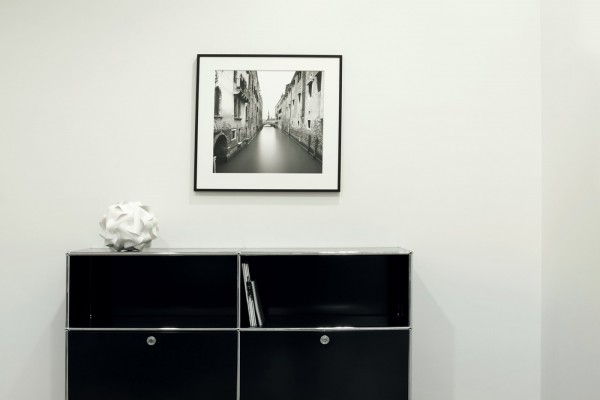Orderly chaos or clean lines: hanging your paintings matters
Churches, Feb. 7, 2019 - Choosing a piece of art is as exciting as the task of finding the right place for it. Paintings are a crucial element of the interior design of residential and commercial spaces. They make rooms homely, give them their own character and provide the necessary aha effect. Anyone who wants to rearrange works of art quickly realizes: the right arrangement is what counts. Regardless of whether the pictures are large or small, framed or unframed - they must fit in with the overall picture and ambience of the room. Paintings, photographs, sketches and even lithographs can be presented in a variety of ways. HALBE (www.halbe-rahmen.de/en/) knows the small A to Z of hanging works of art in front of white and coloured backgrounds, in small and large rooms.
The choice of pictures enhances a room
For an artistic work to fit in well, there must be a relationship between the art and its surroundings. The proportions of a room as well as the interior play an essential role in the selection of artwork. Large-format pictures need a lot of space to fully develop their effect and radiance. Especially pictures in XXL format should not compete with voluminous furniture, wild wallpaper and colourful textiles. Small works of art, on the other hand, also work in small rooms and niches. Above a large sideboard or chest of drawers, a large-format "soloist" is a special eye-catcher. The width of the artwork should be no more than 2/3 or ¾ of the width of the sideboard.
A single work of art or a strictly geometric row or grid hanging of thematically related pictures is more in keeping with a clear interior design style. If you like things playful and colourful, you should pick this up with a Petersburg hanging or the use of picture rails to display photographs, etchings and lithographs. In general, make sure that the colour scheme of the motifs is reflected in the furniture and accessories - this not only looks chic, but also gives the room a special flair.
Wall design: Less is often more
Ideally, the wall color is neutral, so that one has various wall design options available, because the wall color affects the effect of the images. "With colored backgrounds, we generally recommend our customers to frame the art objects with a passepartout, so that a calming free space is created between the motif and the wall," says David HALBE, Managing Director of HALBE-Rahmen GmbH. Monochrome walls and muted colours harmonize with almost all works of art and frames. The following applies: the darker the wall color, the more the colorfulness of a picture is emphasized. Across the board modern, stylish yet vibrant, white framed watercolours or etchings look great on a white wall. This plain colour is more varied than you might think - its spectrum ranges from cool shades like snow white and chalk to warm tones like ivory and champagne.

With coloured walls, the art objects should be framed with a passepartout if possible, so that a calming open space is created between the motif and the wall.
The right place is essential for the perfect effect of a picture
Achieving a beautiful picture arrangement requires a little more than simply hanging a piece of art on the wall. In general, hanging pictures in dark corners and above radiators should be avoided. Direct sunlight can also fade valuable artwork and photographs and cause them significant damage. Uniformly diffuse lighting or cleverly placed lighting accents with the aid of gallery spots is ideal.
When designing a room or staircase, the motifs should be similar in content; this makes the hanging self-contained and particularly expressive. A popular and classic form of wall design is the hanging of two or more pictures in a row. The geometric arrangement as a quartet or sextet of related pictures or the same implementation techniques is also very popular. It is important to ensure that all pictures have the same frame and that all distances are identical - the eye is not forgiving of inaccuracies.

Small works of art often look ideal in small rooms or niches in the form of a "Petersburg hanging". This seemingly loose arrangement of pictures conceals imaginary reference lines of the picture edges.
Hanging at eye level
Whether large or small, rectangular or square - the right height for a new picture is quickly found. Apart from design aspects, a picture should always be hung at the viewer's eye level, i.e. the centre or upper third of the picture should be at a height of 1.55 metres. In addition, a work of art needs enough room to breathe. A distance of at least 20 to 30 cm from the edge of the sofa or sideboard to the lower edge of the frame should be maintained.
The size of the art object determines the correct suspension
Single-point hanging is suitable for small and light pictures, as only one nail needs to be driven into the wall. The advantage is that the picture frame always hangs straight or can be easily balanced. For larger or heavy pictures and also landscape format motifs, a two-point suspension with dowels and screws is safer. If you don't want to use nails or screws at all, you can also arrange the works on a piece of furniture or simply lean them against the wall. Picture rails and gallery rails are practical if you like to rearrange your pictures.
![]() Abstract - What to consider when decorating walls with pictures (German)
Abstract - What to consider when decorating walls with pictures (German)
![]() Press release as PDF (German)
Press release as PDF (German)
We have compiled high-resolution image material for you in the following dropbox - image rights @HALBE-Frames
https://www.dropbox.com/sh/kssayn4wd0pj6yw/AAD2b81EL7pAZliDMID1jq1Ga?dl=0





